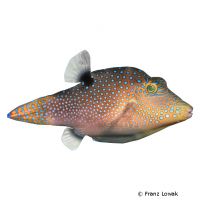Blue Spotted Pufferfish (Canthigaster solandri)
| Blue Spotted Pufferfish Canthigaster solandri | |
|---|---|
| Name | Blue Spotted Pufferfish |
| Name Lat. | Canthigaster solandri |
| Family | Puffers |
| Family lat. | Tetraodontidae |
| Order | Puffers & Filefishes |
| Order lat. | Tetraodontiformes |
| Origin | Indo-Pacific |
| Habitat | Lagoons, seaward reefs |
| Diet | Omnivore |
| pH | 8.1-8.4 |
| Hardness | 8-10 °KH |
| Behavior | Peaceful |
| Keeping | Individual, pair |
| Reef Compatible | With caution |
| Care Level | Difficult |
| Life Span | 5-8 years |
| Protection | No |
| Metric Units | |
| Size | 11 cm |
| Temperature | 22-27 °C |
| Salinity | 33-36 ‰ |
| Aquarium | ~ 250 l |
| US Units | |
| Size | 4" |
| Temperature | 72-81 °F |
| Salinity | 1.020-1.025 sg |
| Aquarium | ~ 65 gal |
Distribution and habitat
Canthigaster solandri are widely distributed in the tropical Indian and Pacific Oceans, from the east coast of Africa to the Tuamoto Islands and from southern Japan to the Lord Howe Islands. They live either in pairs or in small groups of unsexed animals on moderately flowed, sheltered reefs and lagoons with dense coral growth down to 35 m depth.
Maintenance
They require a well-structured aquarium with a reef structure that allows for territoriality and at the same time provides hiding, resting and cover opportunities, with live stones that act as a biological filter and sufficient swimming space. Only lime-rich, heavy metal-free sands, gravels, stones or sea sand of various grain sizes may be used as substrate. Filters, skimmers and heaters are necessary to ensure water quality, as well as pumps to simulate tides, swells and bottom currents. Lighting must correspond to the species-appropriate day-night rhythm of the animals
| Salinity: 33-36 ‰ | pH value: 8.1-8.4 |
| Carbonate hardness: 8-10 °KH | Nitrate content: 2-8 mg/l |
| phosphate content: 0.01-0.1 mg/l | nitrite content: 0.0-0.05 mg/l |
For salinity, an average value should be aimed for, which may only vary slightly by +/- 0.5 ‰. Ammonia and ammonium must not be measurable. Special attention must be paid to constantly good water quality.
Diet
In nature they feed on zooplankton and polyps, but also need plant food. The feed change usually succeeds without problems. The food supply should consist of a combination of small mysis, krill and artemia. In addition, chopped shrimp and crab meat as well as a frozen food mixture enriched with vitamins. High-quality flake and granulated food with a high vegetable content is also often accepted after a period of acclimation. It is recommended to feed small portions several times a day, this reduces intra-species aggression and protects lower animals in the aquarium. Regular and varied feeding promotes health and increases resistance
Behaviour and compatibility
It is recommended to keep them singly or in pairs. They behave very territorial within the sexes. Keeping them in pairs is only possible in a much larger and richly structured tank. Towards other fishes they behave peacefully.
Sex dimorphism
External sex differences are not known
Reproduction and breeding
There are no known reports of successful breeding in the aquarium.
Important
They require hard-shelled crustaceans, mussels and snails to wear down their constantly regrowing teeth. Occasionally they also scrape calcareous red algae from the reef structure.
When threatened, they can inflate to twice their size by filling their expandable stomach with air or water
A cup filled with aquarium water should be used for transferring or inserting them so that they do not become airborne.
Their flesh is partially poisonous
If different species are kept together, make sure that the fish match each other in terms of water quality and temperature requirements, as well as their social behavior, and that the setup meets the needs of all species kept together. Newly introduced fish must be acclimated slowly to the water in the aquarium
Further literature can be found in your pet store.
References
Text: petdata; Image: Franz Lowak
Source: ENGELMANN (2005): Zootierhaltung - Tiere in menschlicher Obhut: Fische, Verlag Harri Deutsch; KUITER & DEBELIUS (2007): Atlas der Meeresfische: Die Fische an den Küsten der Weltmeere, Kosmos Verlag
- Gemäß § 21 Abs. 5 Tierschutzgesetz idgF
